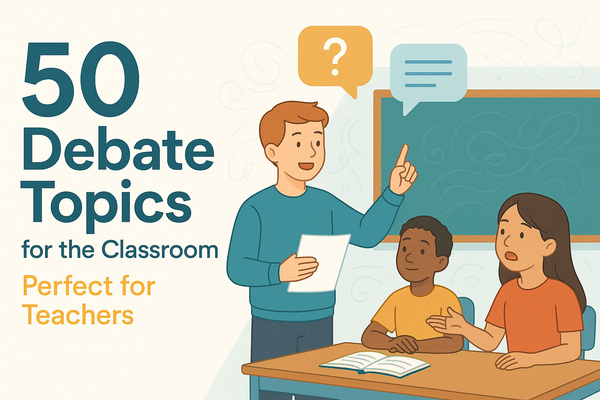Transform Test Prep by Incorporating Fun Ways to Review for a Test

Preparing students for tests does not have to feel like a chore for you or your students. Incorporating engaging and fun ways to review for a test can be a game changer in your teaching style. The key in these sessions lies in transforming test prep from a dull routine task to a fun and engaging experience.
As a teacher, it is important to pinpoint your students’s strengths and identify areas where they need extra support. In this way, you can ensure that they are not just memorizing information but also understanding it. This blog will explore 10 fun ways to review for a test.
How to Make Test Prep Fun for Students
Test prep does not have to be boring or stressful. Using technology in the classroom can transform review sessions into exciting and engaging experiences. Technology is a part of every student’s life, so incorporating technology into test prep meets their expectations and makes the experience more natural and enjoyable.
One great way to do this is by using Teacherbot.io, our AI-powered tool that helps teachers create engaging resources. You can tailor these resources according to your student’s needs and preferences. There are a variety of test prep strategies that can make students feel confident and ready; some of them are as follows.
- Gamification: You can turn quizzes into fun games to boost participation. This gamification can be done using online AI quiz generators to ease your workload.
- Categorizing Activities: Helping students categorize and organize concepts can make it a lot easier for them to understand every concept.
- Real-World Connections: Helping students connect the knowledge they learn with the real world makes every concept more relatable and engaging for them.
- Collaboration: You should also encourage teamwork and peer learning when students are preparing for tests.
10 Fun Test Review Ideas That Work
Here are 10 creative and fun ideas to make your next test review session both effective and enjoyable.
1. Socratic Seminar
A Socratic Seminar is a powerful and interactive way to review for tests while encouraging critical thinking and active participation. In this method, students lead discussions, present their ideas, ask thought-provoking questions, and debate key concepts from the material.
As a teacher, your role will switch to being an observer, and you will allow the discussions to flow naturally, giving students the space to express their thoughts and knowledge. You should make notes of the students’ performance and identify the areas where they need extra support so you can help them strengthen those specific concepts before the test.
2. Board Race
You can turn test reviews into a competitive game with a board race. Start by dividing the class into two teams and letting them select a representative. You will present the question related to test material and watch representatives race to the board to write the correct answer. The first team to answer wins.
The activity goes beyond the knowledge recall, as students will coordinate with each other as a team to decide on the final answer. You can also rotate the representatives to allow each student to participate and contribute to the team’s success.
3. Review Relay Race
Bring movement and excitement into your test prep with a Review Relay Race. Divide the class into teams and create a relay setup with review questions stationed at various points around the room. Each team member races to a station, answers the question, and then passes the baton to the next runner.
The baton can only be passed if the question is answered correctly. This keeps the focus on accuracy as well as speed. The first team to complete the relay wins, and this will ensure a productive and exciting learning experience for everyone.
4. Study Island’s Group Sessions
Study Island’s Group Sessions bring an exciting, game-based approach to test review, designed to energize both students and teachers. This activity transforms traditional review into a collaborative and competitive experience.
These sessions are perfect for settings where you could make it more like a 1:1 setting or small groups. You will have to interact with them all and monitor their real-time progress while they discuss and support each other in understanding different concepts.
5. Escape Room Challenge
You can turn your classroom into an adventure with an escape room challenge. Design a series of puzzles or review questions that students must solve to unlock clues and progress through the "room." Each clue brings them closer to their goal, whether it is a hidden reward, bonus points, or the ultimate sense of achievement.
This activity combines problem-solving, teamwork, and subject review, making it an exciting way for students to apply their knowledge in a creative and interactive setting. You can add elements like locked boxes, hidden codes, or riddles to enhance the experience and keep students engaged.
6. Glow Up
You can create an unforgettable experience for your students by dimming the lights, covering the windows, and filling the room with glowing accessories. Whether it is a glow bracelet or a glow stick, students get to collect one with every correct answer. This element of fun turns ordinary review sessions into an exciting experience.
These added visual elements captivate students’ attention and make the review feel more like an exciting challenge than a standard prep session. You can even dedicate one day to this activity before a test and take the learning experience to a whole new level.
7. Castle Siege
Bring history and strategy into your test prep with a fun and competitive Castle Siege game. Students work in teams in this activity to defend their castle from attacks. Correct answers to a test review question earn them an offensive strike against the opposing team’s castle.
You can have students create their own castles using paper or cardboard or even draw them on the whiteboard. The physical element adds a fun twist. During the siege rounds, students can toss balls of paper at the opposing team’s castle, making the game even more engaging and hands-on.
8. Classroom Topic Centers
Transform your classroom into a series of stations, each focused on a different study area relevant to the upcoming test. Divide students into small groups and assign each group to start at one center. Set a timer, and have the groups rotate to the next center after a set period. At each station, students engage with review materials, activities, or discussions centered on the topic.
This collaborative setup promotes active learning, allowing students to interact with peers, ask questions, and apply their knowledge differently. By the end of the rotation, every group will have engaged with each topic, reinforcing the material in an engaging format.
9. Hot Stew Review
In this fun and interactive PowerPoint-based game, students work in teams to answer a series of 20 review questions. After each question, they choose a “vegetable” from a virtual pot of stew, and the next slide reveals how many points they have earned. The point values are randomly assigned and can be positive or negative, adding an element of surprise and excitement with each choice.
The unpredictability of the point system keeps all teams engaged, maintaining a sense of anticipation throughout the game. Students stay focused as they collaborate to answer questions and strategize their next move, all while reinforcing their knowledge.
10. Whiteboard Brainstorming
Give each student a small whiteboard and dry-erase marker in this test review activity. Pose a thought-provoking question related to the material (e.g., "What are the main causes of climate change?"), and have students jot down their ideas, keywords, or solutions on their whiteboards.
After a set amount of time, invite students to share their answers with a partner or the entire class. This activity reinforces their knowledge and encourages active participation and collaborative thinking. It is a great way to gauge student understanding and quickly spark key discussion.
Benefits of Reviewing Test Material in a Fun Way
Reviewing test material in a fun and interactive manner can significantly impact student engagement, retention, and overall learning experience. Here’s how turning test prep into a fun activity can benefit both students and teachers.
Increased Engagement
Fun activities break the monotony of traditional test prep and catch students’ attention. When students are actively engaged, they are more likely to retain the information.
Encourages Collaboration
Many fun review games, such as group activities or competitions, promote teamwork. Collaborative learning allows students to exchange ideas, clarify doubts, and reinforce their knowledge together.
Reduced Stress
Test prep can be stressful, but by adding fun elements, you create a less intimidating atmosphere. When students enjoy the review process, they are less likely to feel anxious.
Motivates Consistent Effort
Fun review activities help maintain student motivation, especially when traditional study methods might feel tiring. You can also incorporate brain breaks if you are using traditional ways to review for a test.
Boosts Classroom Morale
When students enjoy their learning experiences, the overall classroom atmosphere becomes more positive. Fun activities often lead to increased enthusiasm.
Conclusion
Incorporating fun into test prep makes reviewing more enjoyable and enhances student engagement, retention, and collaboration. Turning your review sessions into interactive and exciting experiences will help your students feel more confident and motivated, ready to ace their exams.




